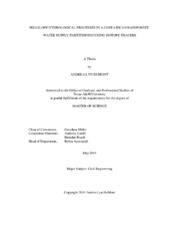| dc.description.abstract | Costa Rican tropical premontane rainforests are among the world's most valuable ecosystems in terms of diversity of animals, plants, and natural resources. These environments are dependent on water resources which fluctuate in quantity during the dry and wet seasons and which are significantly influenced by vegetation feedbacks. Currently, tropical premontane forest watersheds are insufficiently characterized in terms of groundwater and stream water interactions due to their limited accessibility and complex geological conditions. However, water produced from these watersheds is a critical renewable resource in Costa Rica. It plays a significant role in the production of downstream hydropower and acts as a supply for water distribution systems in many rural areas.
In this study, stable isotope tracing of δ^(18)O and δD was used to determine the source of water in a stream, and the relative contributions of water budget components (e.g., groundwater, soil water). Samples were collected beginning in the dry season and continuing through the wet season from 2013-2014 as the soil became progressively wetter. The δ^(18)O and δD samples represent precipitation in the tropical forest, as well as groundwater, soil water, and stream water at several locations. This data is important to understanding the influence of vegetation and hydrogeological properties on groundwater and stream water in tropical headwater catchments.
Streamflow averaged 0.06 m^(3)/min in baseflow and greater than 0.10 m^(3)/min during storms. Groundwater was seen to contribute to 80% of streamflow and was the main stream component even during storm events. A small proportion of the total amount of streamflow came from interflow and soil water (1%).
Additional findings indicated that precipitation, about 4200 mm/yr, in the rainforest can be recycled source water. Storm tracks alternate from distribution starting in the Pacific Ocean to the Caribbean Sea over the course of the wet season. Overall precipitation was seen to be dominated by deep convection and enhanced during the wet season due to the North American Monsoon and the Intertropical Convergence Zone. | en |


